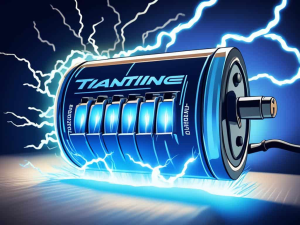Do you know about Double-layer electrolytic capacitors?
What is a Double-layer electrolytic capacitors?
Double-layer electrolytic capacitors are also called supercapacitors.
Supercapacitors are capacitors that can store large amounts of energy, typically 10 to 100 times more energy per unit mass or volume than electrolytic capacitors. They are more popular than batteries because they can be recharged faster and easier, and charge can be transferred faster.
This means in practice that they: Charging is much faster than batteries, Can store more energy than electrolytic capacitors, Service life (measured in charge/discharge cycles) in between (larger than rechargeable batteries, smaller than electrolytic capacitors)

For life comparisons, consider that while electrolytic capacitors have an unlimited number of charge cycles, lithium-ion batteries average between 500 and 10,000 charges. However, the lifetime of double-layer electrolytic capacitors ranges from 100,000 to 1 million cycles.
Like ordinary capacitors, supercapacitors have two separate plates. The plates are made of metal coated with a porous substance, such as powdered activated carbon, which effectively gives them a larger area to store more charge. Imagine that electricity is water: whereas a normal capacitor is like a cloth that wipes out only a little of the spill, a supercapacitor’s porous plate makes it more like a thick sponge that can absorb many times over. Porous double-layer electrolytic capacitors plates are sponges!

What about the partitions between the boards? In ordinary capacitors, the plates are separated by a relatively thick dielectric made of mica (ceramic), a thin plastic film, or even just air (which acts as a tuning knob in a radio in a capacitor like this). When the capacitor is charged, a positive charge forms on one plate and a negative charge on the other, creating an electric field between them. The field polarizes the dielectric so that its molecules align in the opposite direction to the field and reduce its strength. This means that the plate can store more charge for a given voltage. This is illustrated in the figure you see here.
Types of Double-layer electrolytic capacitors
As mentioned earlier, supercapacitors utilize two basic energy storage principles, namely electrochemical pseudocapacitance and static double-layer capacitance. Based on this, there are three different types of supercapacitors. They are:
Double-layer capacitor
Pseudo capacitor
Hybrid capacitor

Double-layer capacitor
In a double-layer capacitor, the storage of electrical energy is achieved by charge separation in a Helmholtz double layer. This acts as a boundary between the conductor electrode and the electrolyte.
The electrodes are made of activated carbon or derivatives with a larger electrostatic double layer capacitance than the electrochemical pseudocapacitance.
Pseudo capacitor
They have polymeric conductive electrodes or transition metal oxides with large electrochemical pseudocapacitors.
The storage of electrical energy is an electrochemical process through a REDOX reaction in which specific absorbed ions are embedded on the electrode surface.
Hybrid capacitor
Here, the electrodes are asymmetrical, with one electrode exhibiting electrostatic properties and the other electrochemical capacitance. The concept of ultracapacitors and ultracapacitors is proposed because both pseudo-capacitors and double-layer capacitors contribute indivisible to the total capacitance of electrochemical capacitors. This helps identify hybrid devices that are both like batteries and supercapacitors.
What are Double-layer electrolytic capacitors used for?
If you need to store a reasonable amount of energy over a relatively short period of time (from a few seconds to a few minutes), then you’ll have too much energy to store in a capacitor and you won’t have time to recharge the battery for it, a supercapacitor may be just what you need. Supercapacitors are already widely used as the electrical equivalent of flywheels in machines – “energy reservoirs” that smooth the power supply to electrical and electronic devices. Supercapacitors can also be connected to batteries to adjust the power they provide.
A common application is in wind turbines, where very large double-layer electrolytic capacitors help eliminate the intermittent power provided by the wind. In electric and hybrid vehicles, supercapacitors are increasingly used as temporary energy storage for regenerative braking (the energy wasted when the vehicle is usually parked is temporarily stored and then reused when driving again). The motor driving the electric vehicle uses a power supply with a rated voltage of hundreds of volts, which means that in a typical regenerative braking system, hundreds of supercapacitors in series are required to store just the right energy.

Double-layer electrolytic capacitors Vs batteries
Batteries are widely used in specific sizes and weights, and have better energy density. Supercapacitors are high capacity capacitors with high power density. Compared to batteries, supercapacitors have the ability to charge and discharge quickly and can cope with low temperatures, high reliability and low impedance.
The cost of batteries is low, while the cost of ultracapacitors is high. Supercapacitors are capable of self-discharging. In a battery, the operating voltage determines the charging and discharging modes. In a supercapacitor, the allowable voltage depends on the type of dielectric material used between the plates. And the electrolyte in the capacitor may increase the capacitance.
Batteries include lead-acid batteries, Ni-MH, Li-PO, Li-ION, LMP and so on. double-layer electrolytic capacitors include organic electrolytes, aqueous electrolytes, ionic liquids, mixtures and pseudo supercapacitors. Batteries are used to store large amounts of energy, and supercapacitors are used to provide high power density.
Conclusion:
In a word, Double-layer electrolytic capacitors has great potential to explore in the future. if you would like to learn more, please still keep in touch with us. Maxworld is devoted to designing and developing better performance battery for your equipment.











